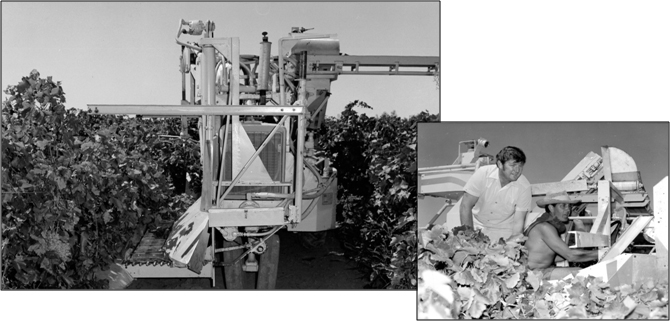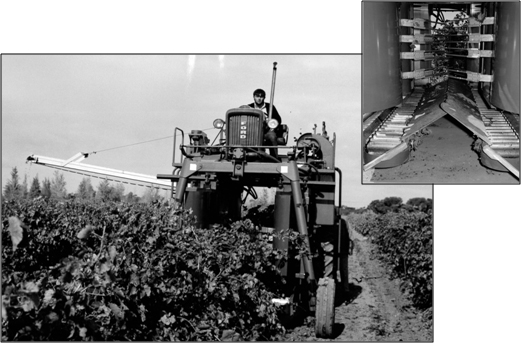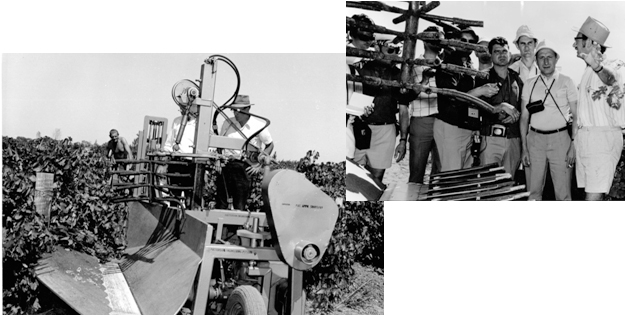Transforming the Australian Wine Industry
So dramatic was the growth of the Australian wine industry through the 1980s and 1990s that much of the foundation research that made this expansion possible has disappeared beneath the avalanche of its own success. Until recently wine was one of Australia’s fastest-growing export industries, yet only four decades ago very little table wine was even made in Australia. The wine-grape industry was primarily a producer of sherries, ports and other fortified wines. Only limited quantities of wine were exported, yet predictions have been made within the international wine trade that by the middle of the twenty-first century Australia could be one of the world’s largest producers and exporters of premium wine.
The transformation, already, has been little short of a revolution, and stems essentially from three crucial research decisions made in the mid-to-late 1960s. They were made against opposition, mostly from agriculture departments which believed CSIRO had no place in horticulture or viticulture, and they were the actions of one man – a feisty plant physiologist named John Possingham. The initiatives he stubbornly pushed after being appointed Officer-in-Charge of the Commonwealth Research Station, a CSIRO outpost at Merbein, Victoria, in 1962 were the introduction, for research, of improved vine stocks from all the main wine-making countries in Europe, plus new virus-tested varieties from the Davis Campus of the University of California; the development of new nematode-resistant root stocks, and most significant of all, mechanical harvesting and pruning. When combined, Australia in a few short years had new, improved vines bred to produce premium wine grape varieties under Australian conditions. In addition, the industry could also take advantage of Australia’s large areas of irrigable land, particularly along the River Murray where the expansion began.
An opportunity arises out of creative thinking
The Possingham saga, which laid the foundations for the growth of a new wine industry, began in the early 1960s when he accepted appointment to Merbein as Officer-in-Charge of the newly renamed Horticultural Research Section at the time Otto Frankel was replaced by John Falk as the head of Plant Industry. Possingham didn’t really want the job as Merbein was then considered a remote backwater for a researcher, but he saw it as an opportunity and was determined to make the move worthwhile. By 1967, five years later, the research under Possingham had become so significant that the section was upgraded to become the Division of Horticultural Research, with Possingham as its first Chief. He had also escaped permanent encampment in the remote location of Merbein by convincing the Executive of the need also for a laboratory in Adelaide. Possingham’s first move was to begin a wine grape research program, which put him offside with everybody, including his superiors in Canberra. As he recalled:
‘There was a certain wowserism about wine research, plus wine was not an export industry and the CSIRO’s main agricultural focus was on export industries, a hang-over from the CSIR days and the deal that made domestic industries the responsibility of agriculture departments. But we were working on sultanas for drying, and a wine grape is the same as a drying grape so it seemed silly to not be doing this research – and besides, I’d been taught that the CSIRO was put here to do something useful.’
Fortunately for Possingham he had an important ally on the Executive, Walter Ives, a shrewd economist who had also been a strong supporter of dissident pastures researcher Jack Davies.
A brainwave in the USA – mechanical harvesting
In 1964, Possingham gained permission for a world trip to find out what grapevine and wine research was being done elsewhere. This was when he became aware of two prototype mechanical harvesters at the American universities, UC Davis in California, and Cornell University in New York State. He was aware that in the future in Australia, hand harvesting of grapes may become more difficult owing to a shortage of seasonal labour. As he recalled:
‘If ever I had any foresight it was there. I decided this had to be the way to go. So back in Australia I immediately applied for a grant to employ some extra people to study mechanical grape harvesting. Initially the Executive were not convinced and I had to have two further meetings before I was able to convince them of the merit, but that’s the way it was. You had to sell your idea, plus demonstrate you had enough enthusiasm to see it through.’
As soon as he was given the go-ahead, Possingham sent one of his staff, Peter May, to the US to try to acquire the prototype harvesters. A degree of mystery shrouds the actual ‘negotiations’, but the speed with which they were suddenly en route to Australia still puts a wry smile on Possingham’s face nearly forty years later. The story goes that May convinced the Americans to part with their machines-for no payment, given they were sitting idle because unionised grape pickers had blocked their adoption by industry. May then contacted the CSIRO’s liaison officer in Washington, Clyde Garrow, who had previously been with the CSIRO Division of Protein Chemistry in Melbourne. May told Garrow he had a big machine he needed to get home in a hurry. Garrow had a reputation as a networker and in no time the proto-type Cornell harvester (built by Chisoholm-Ryder, NY) was being wheeled into the belly of an RAAF Hercules transport plane. The other prototype harvester, from the University of California at Davis, (built by Up-Right Inc, California), was put on a ship to Melbourne.

A period of intensive experimentation followed at the Merbein research station mainly (a) to test overall feasibility of machine harvesting, (b) to evaluate the relative merits of horizontal and vertical shake harvesting and (c) to evaluate the systems of vine training associated with their use. Soon after, a representative of one of the American companies arrived to re-claim one of the machines, which the company had a licence to market. Possingham agreed to return the disputed prototype, but the upshot was the American company ended up shifting its manufacturing to Mildura because Australia became the first real market.
The early Chisoholm-Ryder machines were vertical shake machines, with later models removing the grapes by horizontal shaking against the foliage. The original Up-Right harvester, as used by CSIRO, also employed a vertical impactor. It was replaced on the market by a completely redesigned model, a convertible machine that could incorporate a vertical impactor, a horizontal shaker (similar in design to the Chisholm-Ryder OW model), or a transverse impactor, which shakes the foliage by rubber fingers moving in an elliptical, horizontal path. In 1970, Patterson Engineering Pty of Mildura, Victoria, Australia, built a prototype machine which harvested one half of a row during one passage. It was basically one half of an Up-Right vertical impactor unit and could be mounted as a saddle on a standard Ford 3000 tractor which provides the power for the hydraulic system driving one set of impactors, an over-the-row conveyor and a fan. It was launched on the market in 1973. The Chisholm-Ryder and Up-Right machines straddle the row and harvest all of the fruit in one passage.

Fortuitously, the work being done at Merbein caught the attention of French viticulturalists, from whom Possingham was keen to acquire premium vine stocks. It became a valuable relationship. The French were the next to adopt mechanisation, and in turn became an important supplier of vine cuttings to Possingham.
The concept of mechanised vineyards is taken up by industry
The prototype harvesters had been working on the Merbein research station for two or three years when in the late 1960s there was renewed interest in wine-making along the River Murray – the location of a successful, but brief table wine industry in the 1880s and 1890s before the vines around Rutherglen and the eastern end of the Murray were wiped out by the insect, phylloxera. Several new, large vineyards were planted, but a shortage of pickers looked like bringing the latest venture to a premature end. Possingham, by now absolutely convinced of the value and feasibility of mechanisation, threw himself into promoting his ideas among vineyard managers.
The concept of mechanised vineyards caught on and was rapidly cemented as the new way to prune and harvest vines on large acreages. It allowed the Australian wine industry to be the first to be able to think big. In the early 1970s in the South Australian Riverland, companies like Yalumba, Tolleys and Orlando started planting 200- to 400-hectare vineyards, which would have been inconceivable without mechanical harvesting.

Improving the quality and yield of the vines
The next step facing the research team at Merbein was to improve the quality and yield of the vines and the rootstock. An important consequence of mechanised pruning and harvesting was that large vineyards could now comprise a mix of high-flavour / small-bunch grape varieties which were otherwise too expensive to pick by hand. Significantly, these included the premium varieties that have since become the backbone of the Australian industry – Chardonnay, Sauvignon Blanc, Shiraz, Semillon, Cabernet Sauvignon, Cabernet Franc and Pinot Noir. Possingham’s priority was to bring in premium wine grape varieties and he travelled to all the world’s leading wine regions, especially France, to arrange for cuttings to be sent to Merbein. The CSIRO laboratory soon became a repository of the best genetic stock available from Europe, and of the very latest virus-tested vines from California. As John Possingham recalled:
‘Because I studied in England – one of the last of the generation of recruits who CSIRO sent overseas to do their PhDs – I was always aware of the enormous body of traditional viticultural and horticultural knowledge in Europe and I was keen to dive into this. So from about 1970 onwards, for example, we never had a summer without a French, Italian, German or Swiss viticulturalist working with us, and that knowledge contributed enormously.’
The imported vines were established at Merbein and their performance under Australian conditions tested as part of the long-term vine breeding program Possingham had set up at Merbein under Alan Antcliff. The aim was to breed grape varieties that were suited to hot inland irrigation conditions. The cuttings were given also to state agriculture departments to multiply up and develop further for growers. Possingham believed this was perhaps the CSIRO’s most important contribution to the development of the Australian wine industry, although he emphasised that he had imported the vines for research, not with any intention to directly assist a new industry. This was left to the agriculture departments which became the main drivers of change within the industry. However Alan Antcliff did breed a light red wine variety called Tarango, which became a successful seller for the winemaker, Brown Brothers. He also released a white wine grape Taminga that has had limited success, and two drying varieties that are widely used.
The development of Ramsey rootstock
The final achievement, as far as opening the gate to the wine industry’s future by Possigham’s group was Max Sauer’s application of the imported Ramsey rootstock – the basic rootstock onto which the different wine grape vine varieties are grafted. This vigorous rootstock is resistant to attack by nematodes (a serious problem for vines in many sandy Australian soils), the troublesome phylloxera insect, and it is also salt tolerant. As groundwater salinity rises, this one development may yet become one of the CSIRO’s most significant contributions to Australian viticulture. Even in 1991 it was estimated the increased productivity resulting from this rootstock research was worth about $9 million a year. Against this, total research expenditure had been about $720 000 by CSIRO plus about $300 000 by agriculture departments.
National and international impact
The success of the Australian wine industry today speaks for itself, but an apt, final summary of the role and value of the initial research was penned in 1994 in a letter to the Melbourne Age by wine industry consultant and a former manager of Penfolds Wines, Ian Hickinbotham. It was at the time Possingham had just received the 1994 Sir Ian McLennan Achievement for Industry Award for his contributions to the Australian wine industry. Hickinbotham wrote:
‘In your editorial, 13 / 9, you state in part, ‘One of the most valuable strengths of the CSIRO is its ability to channel research energy to national problems’, but there is another aspect: If the wine industry experience is typical, ordinary mortals have no conception of what could be – only the true scientists have the imagination, but they need space.
Australia is now world leader in the mechanical harvesting and pruning of vines, thanks to research done by the CSIRO-which our wine industry certainly did not request. We now have the world’s highest percentage of vines mechanically harvested. Being involved with the first mechanical harvester to be used commercially, I knew Dr John Possingham and his CSIRO team when they imported the first mechanical harvester 25 years ago and industry leaders queried the waste of money. Today, much of our wine export success can be directly traced to that pioneering and leadership. Because we could harvest mechanically, meaning cheaply, wine growers were able to introduce superior clones of vines and grow small bunches of grapes with small berries. Those same grapes can cost $600 a tonne to pick by hand – about half their selling price. Since flavour is mostly in the area of the grape skin, these new berries yield superior flavoured wines which we currently enjoy in the form of Coonawarra Cabernet Sauvignon and Shiraz dry reds, for example. The very wines that have led Australia’s foray into the EC. This spectacular contribution by free spirits, saving some $300 million per annum, could not have happened if ordinary folk on committees had determined the ‘national problems’, because there were no problems as such in the Australian wine industry.’
John Possingham is nationally and internationally recognized for his contributions to the Australian wine industry. He was elected: Fellow of the Australian Academy of Technological Sciences and Engineering (FTSE) in 1979, Fellow of the Australian Institute of Agricultural Sciences (FAIAST) in 1997, Member of the Russian Academy of Agricultural Sciences in 1992 and Life Member of the International Society for Horticultural Science in 2002. He was made a Member of the Order of Australia (AM) in 1990, and awarded a CSIRO Medal for Research Achievement in 1992, the Sir Ian McLennan Achievement for Industry Award in 1994 and a Centenary Medal in 2001.
In reflecting on these achievements in 2012, John Possingham wrote:
‘Peter May told the French industry what we were doing with machines as he was fluent in their language and this helped a lot. Alan Antcliff did not have a lot of involvement in the overall project as he concentrated his efforts on vine breeding. The grape vine collection that we built up provided the best vines that were available world-wide for the purposes of breeding and evaluation These vines also became the source of improved clones and varieties for the Australian industry. Some of the virus tested Californian clones of Cab Sav gave massive yield increases compared with what we had. We were obligated to get the Departments of Agriculture to release and disperse this material which revolutionised the wine industry. However we had to fight the quarantine authorities in Canberra and Department of Agriculture pathologists to get the new varieties and even the virus tested clones into the country. This is why I had to send Ron Woodham from Merbein to Davis, California to learn about virus testing and set up a virus indexing facility at Merbein. Otherwise we would have never got access in Australia to some of the best clones we continue to grow. The major viticultural step forward that the wine industry of Australia made, involved inputs from a dedicated group of researchers who were prepared to work together with me as a team. A series of problems were overcome that enabled the industry to produce, and economically harvest, quality grapes from selected clones of grapevines grafted to salt- and nematode-tolerant rootstocks..’

Sources
- Collis B, 2002, ‘Golden Vines’, in Fields of Discovery, Australia’s CSIRO, pp 242-248, Allen & Unwin, Crows Nest, NSW, Australia; which has been edited for the above account.
- Possingham JV, 2012, Personal communication
- Walker R, 2012, Personal communication
- Science adds sparkle to gold and wine, 1994 (Media Release)
- Possums Wines at www.possumswines.com.au
- DrJohnsWines at www.drjohnswines.com.au
